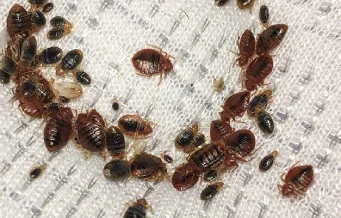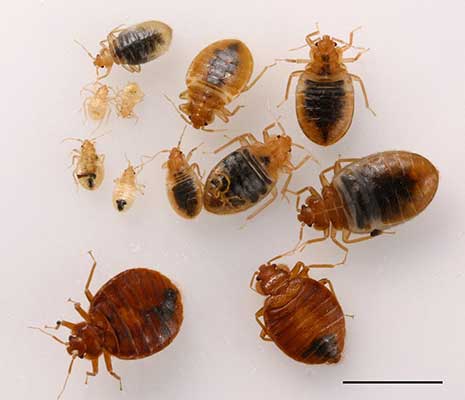We all know that bed bugs are parasitic insects that feast on human blood in the dead of night. But for those who have not seen these pests up close, the bugging questions are what do bed bugs look like, can we differentiate these blood-sucking creatures from other household insects, and is there an easy way to spot them? Based on your geographical location, it may be challenging to distinguish between a bed bug and other small insects.
And since time is of the essence when dealing with bed bugs in your home, you need to identify them as fast as possible. If left untreated, these pests can multiply and cause a full-blown infestation. Therefore, homeowners must learn how to identify bed bugs for them to take the proper corrective measures.
Knowing what to look for to identify bed bugs is the first step to controlling them. In this piece, we’ll look at the unique features that make bed bugs different from other insects.
Physical Signs that May Point to the Presence of Bed Bugs
Looking at the physical signs is one way of identifying whether you have a possible infestation.
Before you even see the bed bugs themselves, there are a few pointers that may indicate their presence:
- Reddish or rusty stains on mattress covers and bedsheets resulting from bed bugs being crushed.
- Dark spots on beddings. These are bed bug excretes.
- Pale yellow skins are shed by the nymph, as well as the pale-white eggs and eggshells.
What a Bed Bug Looks Like?
Once you sense that you may be having bed bugs in your home, here are some features that will help you locate and identify them.
Color
Bed bugs have different colors at different growth stages. Their eggs are light cream, while the nymph bed bugs boast a translucent or whitish-yellow color and a bright red translucent abdomen after feeding. Adult bed bugs are red/brown, but their bodies turn rusty or reddish after feeding.
Size
These parasites are typically tiny, but bed bug size depends on their stage in the life cycle.
Eggs (1mm)
- 1st stage nymph – 1.5 mm
- 2nd stage nymph – 2 mm
- 3rd stage nymph – 2.5 mm
- 4th stage nymph – 3 mm
- 5th stage nymph – 4.5 mm
A fully-grown bed bug measures between 5-7 mm or 3/16 – 1/4 inch long. Simply put, bed bugs are the size of an apple seed.
Shape
Bed bugs have a flat, elongated, oval-shaped body. They have six legs, two antennae with four parts, and tiny wings that are not used to fly. Adult bugs can be seen with naked eyes, so you’ll identify them by their shape.
Smell
These creatures exude a ‘musty-sweetish’ odor secreted by glands hidden on the lower side of their bodies.
Unique Behavior and Habits
Feeding
Bed bugs pierce and suck human blood using small tube-like structures known as proboscis. And although these parasites prefer feeding on humans, experts warn that they can still feed on other hosts such as mammals and birds. Bed bugs can travel 15-20 feet from their hiding place to feed on their target host.
These nocturnal parasites like feeding in the dead of night, but when hunger strikes, they can feast on you during the day, especially when you take daytime naps. The estimated feed time for an adult bed bug is between 3 and 12 minutes. This is how you can recognize bed bug bites:
- The bites, which are usually three to four, form a curved-shape pattern.
- They cause intense itching, mainly in the morning.
- Bites often occur on legs and hands.
- The bites often form small blisters at the top.
Hiding Places
Bed bugs can and will hide in the tiniest of places due to their small, flat, and elongated bodies. The most likely hiding spots for bed bugs are in the cracks on the headboard and bed frame, seams, and mattress tags. If your home is heavily infested, check for these creatures in these places:
- In between the seams of chairs, cushions, and the fold curtains
- Along the drawer joints
- At the junction between the ceiling and walls
- In electrical appliances
- Near the piping
- Under wallpapers and other wall hangings
Living Conditions
Contrary to the notion that bed bugs are brought by dirt and filth, research has proven that these parasites can live in any place their host lives, whether it’s clean or dirty. They can survive in low temperatures of even 46°F (7°C). However, temperatures beyond 113°F (45°C) can affect their metabolism leading to their death. You can now understand why heat is one of the methods used to exterminate these parasites. However, tropical bed bugs require a higher average temperature to breed and reproduce than bed bugs found in other areas.
Bed bugs can be found in different parts of the world, including many parts of the United States. They are prevalent in large travel hubs and cities but can still be found in remote areas.
How to Control and Treat Bed Bugs
Treating bed bugs calls for a lot of coordinated action. For starters, homeowners need to clean their clothing, beddings, curtains, and linens with hot water and dry them thoroughly with the highest dryer setting.
Cleaning and scrubbing mattress seams and cracks will help expose the parasites and their eggs. Vacuuming the bed and the surrounding area regularly is also recommended. Once you’re done vacuuming, the vacuum should be placed outdoors in a tightly secured plastic bag.
These creatures can stay alive for a year without feeding. Therefore, infested items should be cleaned and kept stored for more than a year before being used again. Permanently remove any clutter in the bedroom.
Getting Rid of Bed Bugs for Good
While there are several ways to control bed bugs, you need professional help if you want to get rid of them completely. Qualified extermination experts use a variety of chemicals to kill and exterminate these creatures from your home. They boast vast experience in these matters and advise on what measures to take to avoid bed bugs recurrence once they are entirely banished from your household.



